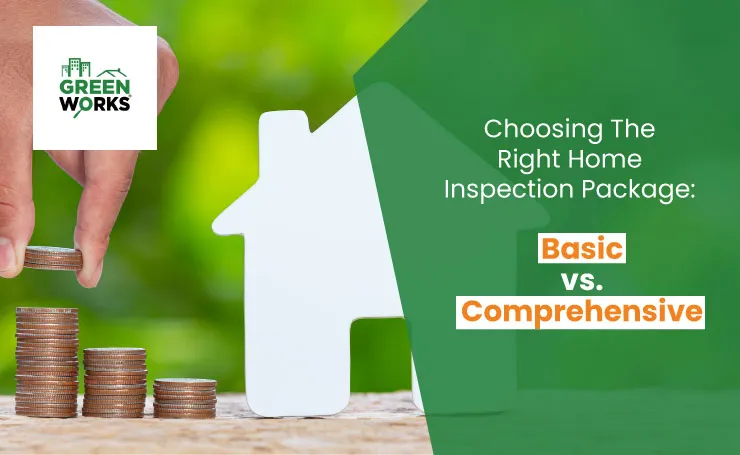Posts

What is Covered During an Interior Inspection?
An interior inspection is a basic aspect of the home inspection process. It provides a detailed evaluation of the condition of the property’s interior components.
Often, homebuyers or homeowners get confused about what’s covered in these inspections. Are the inspections thorough? Do they cover every area within the house’s walls? Do they search even behind the walls?
If you’re wondering about something similar, this blog is for you. This blog will discuss what’s covered in an interior inspection. Making it easier for you to understand what to expect throughout the process.
So, it’s time to peel back the wallpaper and see what’s really ‘undercover’ in the interior inspections.
Let’s break down everything in an interior inspection checklist.
Interior Inspection Checklist
Structural Components
The inspection starts with the most important factor – the structure.
During the process, inspectors check the property’s structural components. The main goal of inspecting this particular area is to identify any potential sign of damage or instability.
For this, the inspector checks whether the walls, ceilings, or floors are in their best condition. As the major issues arise from these areas. Indicating the underlying structural issues.
Even though the inspectors tend to remain inside the property, they ensure nothing is missed. Therefore, they look out for sagging or uneven floors. These may suggest problems with the foundation or support structure.
They also closely inspect the house for evidence of water damage. They check for stains or mold growth that might, in the long run, impact the building’s integrity.
Windows and Doors
After checking the structural components, inspectors focus on windows and doors. They check each of these to ensure they function properly and are structurally sound.
Inspectors ensure windows and doors open smoothly, latch securely, and are free from damage or decay that could affect security or insulation.
Moreover, inspectors pay close attention to the insulation and sealing around windows and doors. This is to ensure that they’re properly weatherproofed, preventing moisture infiltration and drafts.
Inspectors ensure property safety, comfort, and energy efficiency by evaluating windows and doors.
Electrical Systems
During the interior inspection, inspectors will examine the property’s electrical components and complete a surface-level inspection of the indoor electrical system.
They will check the visible components for signs that exhibit issues. These components include outlets, switches, fixtures, some appliances, etc. They do all this to ensure everything is in its correct working order. And most importantly, it follows electrical codes of regulations.
You can always schedule an electrical inspection separately to get a more detailed insight into your home’s electrical system.
Plumbing Systems
During an interior inspection, inspectors ensure they don’t leave any stone unturned. So, the next area they assess is the plumbing system.
The inspector inspects the plumbing system with detailed precision. This is to ensure optimal functionality and prevent potential issues.
Following are some of the components they examine during the process:
- Sinks
- Faucets
- Toilets
- Showers
They evaluate them to find out the signs of leaks, poor drainage, and overall functionality.
Additionally, inspectors thoroughly inspect pipes for signs of water damage or corrosion. Which might lead to leaks or other plumbing problems.
HVAC Systems
When inspecting the major systems, inspectors can’t miss the HVAC system, can they? When inspecting HVAC systems, inspectors aim to ensure the system’s optimal performance. Eventually leading to comfort with your property.
While inspecting the HVAC system, the inspector encompasses a thorough inspection of various components, including:
- Furnaces
- Air conditioners
- Heat pumps
- Ductwork
They examine these systems to identify any signs of damage, wear, or malfunction. Anything that could compromise the system’s efficiency.
Furthermore, they pay close attention to the air filters and vents. They check whether they are properly cleaned and maintain proper airflow. As this directly affects the indoor air quality and circulation.
How to Prepare for an Interior Inspection?
Clean and Declutter
To prepare your home for an interior inspection, you shall begin with cleaning and decluttering.
Start by tidying up your living space to facilitate the inspector’s assessment of different areas. And, of course, to ensure a thorough assessment.
With this crucial step, inspectors will not only have easy access to the areas but also effectively inspect essential components.
Whether clearing pathways to the HVAC unit or ensuring unobstructed access to electrical panels. A clutter-free environment makes the inspection process simple. It also lets the inspector focus on evaluating the property’s condition without unnecessary hindrances.
Make Necessary Repairs
Before you schedule your interior inspection, it’s better to address any minor repairs beforehand.
Now, what repairs are we talking about here? We’re talking about fixing leaky faucets, repairing damaged walls, and replacing burnt-out light bulbs, among other things.
Once you proactively address these issues, you prevent them from escalating into bigger concerns during the inspection. This won’t only polish your home maintenance but also present the home in the best way.
Taking care of these minor repairs beforehand can streamline the inspection process. Also, it can build confidence in the property’s overall condition.
Gather Documentation
During the inspection, inspectors will also look at the documentation related to your property. This might include warranties, permits, and maintenance records. All of these offer valuable insights into the history and upkeep of your property.
Having these documents ready helps you ask whatever questions you have then and there.
Permits provide information about any renovations or additions made to the property. Warranty offers insight into the age and condition of appliances or systems. Maintenance records translate the care and attention your home has received over time. This offers you and the inspector reassurance about the property’s overall condition.
By compiling these documents beforehand, you can streamline the inspection process. Also, ensure a thorough evaluation of your home’s interior.
Conclusion
In conclusion, an interior inspection is an essential part of your homeownership. It offers invaluable insights into the condition and functionality of a property’s interior components.
Inspectors assess structural integrity and mechanical systems. Further examining plumbing fixtures – leaving no stone unturned.
With a thorough understanding of the property’s condition, you can rest assured knowing you have taken the necessary steps to ensure the safety of your investment.
Ready to ensure your home’s safety and efficiency? Schedule your home inspection with GreenWorks Inspections today and gain peace of mind in your investment. Contact us now to book your appointment!




